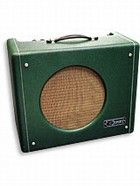
Depending on where your affinities lie, the word “Mercury” can call to mind either the mythological messenger to the Roman gods, or upscale Ford cars. Amp builder Steve Carr’s latest combo shares the moniker, and many of the high-flying, upscale attributes that come with it.
Like the Carr Slant 6V we tested in the November ’01 issue, the Mercury uses nothing but the best components; aerospace-grade polypropylene filter caps, an aluminum chassis, George L’s cables, custom paper bobbin interleaved transformers, hospital-grade power cord, ’50s-style carbon resistors, a Kingpin 60 speaker, and Mallory filter caps. Construction is also of the highest quality, including the dovetailed solid pine cabinet with a floating baffleboard, point-to-point wiring, and an understated Hunter Green tolex with silver piping and tan grillecloth.
The Mercury’s power comes not from winged shoes or a V-8, but from a KT-66 tube. The preamp uses two 12AX7 tubes and a single 12AT7 for the spring reverb. The Carr also runs on a 6L6, KT-88, 6550, or a EL-34, with a simple bias adjustment using a multimeter and screwdriver. The white, top-mounted control panel features knobs/switches for power, standby, volume, treble, bass, and reverb, but also offers a couple of new things to flip and twist, like a tone boost/defeat switch, a high-cut switch, and the most innovative new thing – a built-in power attenuator, which lets the user switch between a lively eight watts down to two watts, then 1/2-watt, and finally an apartment-friendly 1/10-watt.
To test the little green monster, we used a late-’70s Ibanez Artist with stock Super 70 pickups and a Fender ’62 reissue Strat with stock single-coils.
First up was the Strat. And given the Mercury’s inspired design, we weren’t surprised to hear the amp deliver sweet, Vox-like high-end shimmer and round low-end, much like a silverface Fender Deluxe. With the attenuator in the 8- or 2-watt positions and the boost switch in the number one position, chords rang out clear, defined, and very full. Boost switch positions two and three noticeably affected gain and the midrange, while adding just the right amount of edge and drive for blues and crunchy rhythms. And the high-cut switch softened any harsh notes or buzz the single-coils might produce.
With the humbucker-equipped Ibanez, we ratcheted up our test a bit. First, we turned the volume up and jumped the boost switch to 3. This made for more pleasing sounds, where the mids blended well without hurting note clarity – even with a fistful of overdrive.
Next, it was attenuator play time. Having familiarized ourselves with the 8-watt and 2-watt positions, we dropped ‘er into the 1/10-watt position, where the amp maintained a lively tone at a very low volume. None of the amp’s characteristics appeared to suffer; notes stayed defined and the desired crunch stayed crisp. The 1/2-watt position rendered the in-between volume you’d expect, with no recognizable change in tone.
With both guitars, the amp’s reverb was outstanding with a clean, lush sound that added nice ambience without washing out the highs. The Mercury has no footswitchable channels or gain boost, but by manipulating the guitar’ volume controls, we could clean up the sound for rhythm work, and crank it for soloing.
The Mercury’s overall superb quality, in both sound and build, along with the cool built-in attenuator, make it a great studio/small gig amp.
Carr Mercury
Type of amp All-tube Class A 1×12 combo with reverb.
Features Single-ended fixed bias KT-66 output stage, three-position boost switch, treble cut switch, built-in attenuator.
Price $2,095.
Contact Carr Amplifiers, 23 Rectory St., Suite D, Pittsboro, NC 27312, phone (919)545-0747, www.carramplifiers.com.
This article originally appeared in VG‘s June ’03 issue. All copyrights are by the author and Vintage Guitar magazine. Unauthorized replication or use is strictly prohibited.


